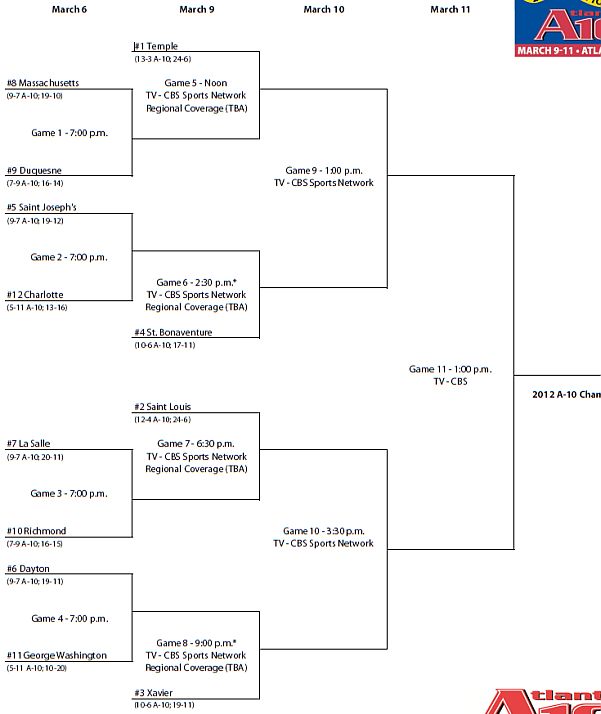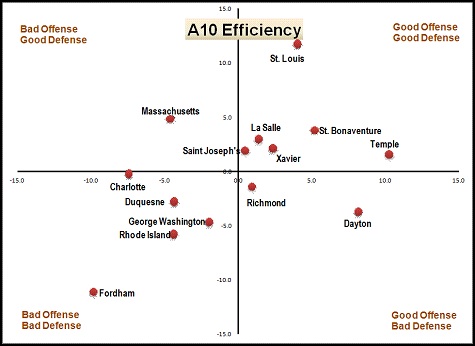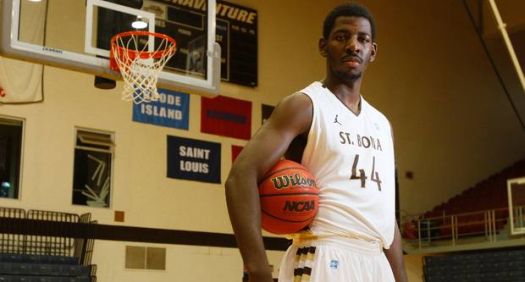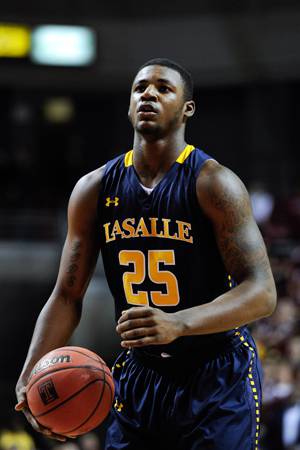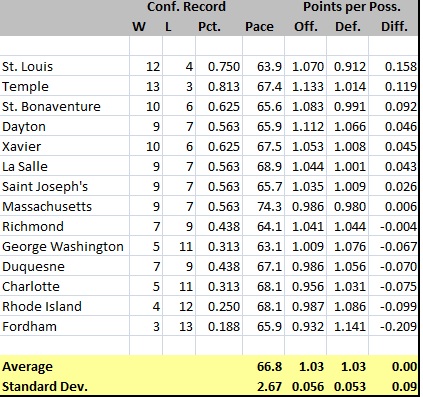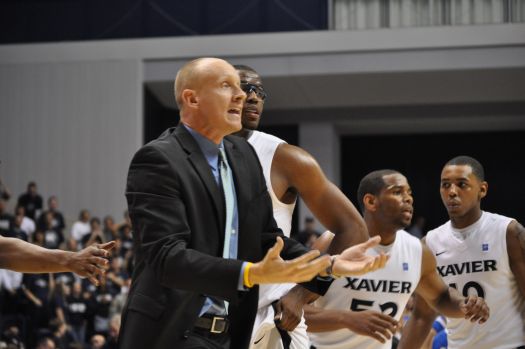Atlantic 10 Tournament Preview & Season Wrap-Up
Posted by rtmsf on March 6th, 2012Joe Dzuback is the RTC correspondent for the Atlantic 10 Conference. You can also find his musings online at Villanova by the Numbers or on Twitter (@vbtnblog)
Tournament Glance
Postseason Preview
All first round games will be played at the campus of the higher seed on Tuesday (3/6) night. Using the log5 calculation, the order of probability of an upset is:
#8 Massachusetts/#9 Duquesne (73-27)
#7 La Salle/#10 Richmond (76-24)
#6 Dayton/#11 George Washington (86-14)
#5 Saint Joseph’s/#12 Charlotte (84-16)
- Probability follows seed this season, a departure from previous seasons. The Dayton/George Washington game will be a return engagement. The Flyers beat the Colonials by 16 at home last Saturday. A rookie coach with a team that may be overconfident could spell upset. But unlike 2010-11, the higher seeds in this round have proven over the last 16 games to be the stronger teams. Seed should hold. If Xavier, Saint Joseph’s and Dayton all win at least once more, the conference will boast seven 20-game winning programs for the 2011-12 season, only the second time in conference history when seven members collected 20 or more wins.
- The Temple/Saint Bonaventure side of the bracket offers (if seed holds) two interesting quarterfinal matchups for a Friday afternoon. Both could well become “do-overs” of games played in the last week of the season. Temple barely beat Massachusetts (at the Liacouras in Philadelphia) on February 29, but only after an overtime period. Neither squad should need much by way of motivation. The Hawks dropped their last game of the regular season to the Bonnies, by five, on the road. A Bonnies win would bolster their NIT credentials (and put them into a winnable semi-final game with either Temple or Massachusetts), while a Saint Joseph’s win could well set-up an all-Philadelphia semi-final that should cause a traffic jam as Big 5 fans and partisans of both schools pile onto the Atlantic City Expressway to see the rubber game.
- The Saint Louis/ Xavier side of the bracket looks vulnerable to a Dayton run if the Flyers get hot again. Every time the Musketeers step on the court their chances for an NCAA hang in the balance. For the past several seasons, the Selection Committee appears to have decided on the number of A-10 bids Saturday night, with the conference’s last invitee sitting on the #11 or #12 line, clearly on the bubble. If Xavier is going to make one last run at a bid, the Musketeers will have to make their case Friday night and Saturday afternoon. If they survive to the Final (especially if they beat Saint Louis Saturday) they will probably get a bid (especially if their opponent is already “in” – ie Temple).
- The Sunday afternoon showcase would be a great opportunity to raise the A-10’s profile nationally. This season CBS shows no conflict with their coverage of the Big Ten tournament final, not the case in previous seasons. If Temple survives to play either Saint Louis or Xavier, that national audience will have a chance to see two Sweet Sixteen contenders fight it out for the A-10.
A Look Back
The experience and winning percentages grids forecasted a paradox – the conference was slightly more experienced overall (and would therefore be more competitive), but individual programs, several of which had dominated conference play in seasons 2009-10 and 2010-11, had lost a significant amount of playing time. Were those programs due for a step back? And would conference play become nevertheless more competitive?
It turns out both were true for 2011-12.
- Rhode Island returned only 25% of their 2010-11 minutes (lowest in the conference) and suffered through a nightmare 24-loss season, the worst in Jim Baron’s 11 year tenure in Kingston. The Runnin’ Rams’ losing season broke a four-year run of at least 20 wins.
- Richmond graduated two All-Conference First Team players (and the conference Player of the Year in 2009-10) and tumbled from an NCAA tournament bid to a losing conference record. The Spiders will have to travel to La Salle win in order to reserve a spot in the conference quarter-finals in Atlantic City on Friday.
- Xavier, a program notoriously well-stocked with players on the bench and in the (recruiting/ transfer) pipeline failed to draw one of the top two seeds to the conference tournament for the first time since 2005-06.
- As for week-to-week competition, the A-10 offered more upsets than in the previous two seasons. Teams finishing #13 and #14 this season won a combined seven conference games, three games better than either of the last two seasons. The #1 and #2 teams lost a combined seven conference games, more than in 2010-11 (three) or 2009-10 (four).
The chart above is a point per possession breakdown, both offensive and defensive ppp for conference games only. It affirms that the “winning” teams – those who finished with winning percentages north of .500 – did so the old fashioned way by posting better than average offensive and defensive (points per possession) numbers in conference play. Three additional takeaways from this breakdown:
- Massachusetts did it with defense this season. Derek Kellogg’s variation on the DDM is still not a dependable system for efficient point production (the UMass program does fish in the same section of the recruiting pond as Kentucky), but the Minutemen defense was good enough to them back into the middle of the conference.
- Defense is also the proximate cause for Saint Joseph’s and La Salle’s turnarounds this season. For the conference average points per possession at 1.01 in 2010-11, the Joe’s were a whopping -0.104 below average, versus +0.019 this season. The Explorers were victims of very inconsistent defense in 2010-11, showing a -0.054 mark in 2010-11 versus +0.012 this season.
- Temple surprisingly did it with offense this season. Fran Dunphy’s teams have been defense-oriented in past seasons. Ramone Moore and Khalif Wyatt have provided the kind of offensive punch missing in previous editions of Owls’ basketball. The two have mastered the difficult task of being both prolific and, in the face of increased attention from opposing defenses, efficient.
Will the better overall competition produce more or fewer NCAA bids? Going into Championship Week the bracketology world is divided, but the consensus is that either two or three A-10 teams will receive bids. Though the conference has drawn three bids annually since 2007-08, those who identify a third A-10 team (usually Xaiver, which has posted a lackluster 5-4 record since February 1) in the candidate pool place that team among either the Last Four In or the First Four Out, a terrible place for a non-power conference program.
All-Conference Team
- Andrew Nicholson, St. Bonaventure: was tabbed the co-favorite for Player of the Year honors by the Atlantic-10 coaches last October. Saint Bonaventure’s center started 114 of the 119 games and each season the team has increased its win total and ranking in conference play. The 6’11” senior has averaged 29.8 minutes, 17.9 points and 8.3 rebounds per game this season. Unlike the previous two POY selections, Nicholson was not a runaway choice, but the senior did what he does best: consistent offensive production every time he hits the floor.
- Ramone Moore, Temple (36.5 minutes, 17.8 points, 3.5 assists per game): The iron man senior guard is the latest in a line of guards mentored by Fran Dunphy since he assumed the first chair on North Broad. In my opinion Moore is a very close second to Nicholson in the POY race.
- Chaz Williams, Massachusetts (16.2 points, 6.4 assists, 2.3 steals per game)
- Brian Conklin, Saint Louis (13.9 points, 5.0 rebounds 1.2 assists per game)
- Carl Jones, Saint Joseph’s (16.3 points, 3.2 assists, 3.5 rebounds per game)
All-Conference Rookie/Freshman Team
- Jerrell Wright of La Salle is the Rookie of the Year. In truth this was a very close race and a promising development for the conference as a whole. If the conference names any of the next two in my list (below) I will not argue as each had a tremendous season. Team success is often the dividing line when honoring upperclassmen. The freshmen can perform without the expectation of carrying the team to a successful. Wright did not carry La Salle to their turnaround this season, credit for that has to be shared by Earl Pettis, Ramone Galloway, Tyreek Duren, Devon White and Sam Mills (to name five more prominent members of the rotation). Wright did the “freshman thing”, but in doing so added the crucial element that made this team a winner on so many nights this season. This time I factored that “team success” into the equation, and that was the bump that moved Wright to the head of this class.
- Kendall Anthony, Richmond (35.4 minutes, 13.4 points and 1.6 assists per game. Kevin Anderson 2.0 perhaps?)
- Jon Holton, Rhode Island (28.5 minutes, 10.2 points and 8.1 rebounds per game)
- Dez Wells, Xavier (25.8 minutes, 10.1 points and 5.1 rebounds per game)
- Pierria Henry, Charlotte (30.1 minutes, 7.1 points and 3.4 assists per game)
Coach of the Year
Though conference watchers this season saw three outstanding jobs (not counting the usual great work turned in by the Temple and Saint Louis staffs), the turnaround of the Saint Joseph’s program should be one of the “conference stories” this postseason. Phil Martelli brought the Hawks “justhisclose” to a Final Four in 2004, but has struggled with team chemistry and discipline, consistent recruiting and fan expectations through many of the eight seasons since.
Beginning with a solid get in Carl Jones back in 2009-10, Martelli assembled a “Fab Class” in 2010-11 that could have provided Jones and company with the right answers last season. But those freshmen, like several classes before, were young and unfamiliar with the coach’s system. Unlike those other post-2004 classes, however, this one stayed with it and in time “got it.” Saint Joseph’s should record win #20 this week which will mark a stunning swing from a 23-loss season in 2010-11 to a 20+ win season in 2011-12.
Newcomer/Transfer of the Year
Chaz Williams, Massachusetts: Derek Kellogg’s Dribble Drive Motion needs a guard who can shoot the ball when there is an opening, to distribute the ball when the defenders converge and the wisdom to know when to do which. Williams, a Hofstra transfer who became eligible this season, may not possess the shot-creating abilities of his two predecessors, but his game does not end with finding his own shot. Williams’ dedication to find the open teammate and crank up the defense has pushed the Massachusetts program into the upper division of the A-10.
Power Rankings
The final net efficiencies from conference play align, Duquesne and Dayton excepted, consistently with the final conference standings. Is the A-10 becoming more predictable? Perhaps, though more likely it means the teams are (with several notable exceptions … ) more consistent. The first round of the conference tournament often holds a surprise or two. This season should be no exception.
Reader’s Take
Team-By-Team Glance
(Seeds and postseason notes are projections)
- Temple (24-6, 13-3), NCAA #6 Seed– The Owls closed out the last week of regular season play with wins over Massachusetts and Rhode Island. Fran Dunphy’s squad needed an overtime period to put the Minutemen away by an all-too-close two-point margin. The win means Temple equaled the 24-win mark they compiled through the end of the 2010-11 regular season. This time, however, Michael Eric is back, and with freshman Anthony Lee having gained valuable playing time in Eric’s absence, the Owls will have low post depth going into the conference tournament and more importantly, the NCAA Tournament to follow. The team earned the #1 seed for the A-10 Tournament, so Coach Dunphy’s squad has an extra two days to prepare for Massachusetts/Duquesne winner Round 1 game Tuesday. The Owls handled the Dukes easily earlier this season. Massachusetts might be a different story, though the squad has to know that a quarterfinal loss Friday will be the last piece of information the NCAA Selection Committee will have to work with as they (most likely) settle on the A-10 contingent sometime on Saturday.
- Saint Louis (24-6, 12-4), NCAA #8 Seed – The Billikens’ closed out the regular season with a crucial win over conference brand-name Xavier Tuesday and Duquesne on Saturday. The Billikens earned the #2 seed in conference play and are set to face the La Salle/Richmond winner from Tuesday night’s opening round. That should be it for Rick Majerus’ squad, but should they survive, they would have a Friday date with Richmond in Atlantic City. And that should definitely be the end of this season. This has to be a very frustrating season for the Billiken faithful. The growing pains were supposed to be last season, with this season’s nucleus, made up of upperclassmen supplemented by freshmen, ready to make their move on the conference elites. The Great Leap Forward has been rescheduled for next season, but Majerus, used to a certain number of players coming and going each offseason, must decide what to do about Mitchell and Reed and who he really wants to keep for next season. Choose wisely as Brian Conklin, Paul Eckerle and Kyle Cassidy will be seniors next season, and it would be a shame if the coach had to waste them while bringing yet another freshman class up to speed.
- Xavier (19-11, 10-6), NCAA #13 Seed/NIT – Though they earned a bye seed (#3) in Atlantic City, Xavier cannot count on the conference’s reputation to get them into the field of 68 this time around. Losing a crucial game to Saint Louis Tuesday denied both a 20th regular season win for the Musketeers (going back to 2005-06) and the last regular season opportunity for a signature win of the type Chris Mack’s squad needs desperately to impress the Selection Committee. Friday they will meet either Dayton or George Washington in a must win game to get them back to a showdown with Saint Louis in the conference semi-final Saturday. A loss Friday would mark the first time since 2004-05 (and the second time going back to 1995-96) that Xavier failed to win 20 games. George Washington has struggled all season long adjusting to Mike Lonergan’s style of play. Dayton, a traditional rival the X-Men have split with this season, should be the bigger challenge.
- St. Bonaventure (17-11,10-6), NIT – The Bonnies gained the last bye seed to Atlantic City thanks to a win over Saint Joseph’s on Wednesday. As part of a letdown perhaps they dropped their last regular season game at La Salle on Saturday; they would have to run the table in Atlantic City to gather a bid (most likely at the expense of Xavier, should the Muskies still be in the conversation Saturday night). Prospects for an NIT bid, their second consecutive postseason bid under Mark Schmidt remain strong with Saint Bonaventure a consensus #6/#7 seed in the three letter tournament’s field. The Bonnies improved their overall and conference win totals for the fourth straight season, due in no small measure to the efforts of Conference Player of the Year (by this correspondent’s reckoning) Andrew Nicholson, along with a solid supporting cast that includes Demitrius Conger, Da’Quan Cook along with freshmen Charlon Kloof and Eric Mosley.
- Saint Joseph’s (19-12, 9-7), NIT – Phil Martelli’s fabulous freshmen stayed and got better (and played some defense), the things necessary to move the program back into the A-10’s upper division. A 3-2 finish put a damper on what should have been a 20-win season going into tournament play. #20 should come Tuesday night when the Hawks host #12 seed Charlotte in the campus-based first round of tournament play. That would go a long way on Hawk Hill to ease the memories of two 20-loss seasons. This squad has no seniors – watch out for next year.
- Dayton (19-11, 9-7), NIT/CBI/CIT – Listed at #6 in my power rankings, the same as the seed assigned by the conference for tournament play, the Flyers will host #11 George Washington in the campus-based first round game Tuesday night for the chance to advance to Atlantic City for the quarter-final round match up with #3 seed Xavier Friday. Hot out of the gate at New Year’s, the Flyers ran to a 4-1 conference record before a four game losing streak brought them down to earth. Since that cold run, Archie Miller’s crew has rattled off a 5-2 record to revive post season talk. The NCAA is off the board (barring a romp through the competition in Atlantic City), but the NIT, a familiar destination for Dayton over the past decade, is very much in play.
- La Salle (20-11, 9-7), NIT/CBI – The Explorers earned the #7 seed in the Atlantic 10 Tournament. They will host #10 seed Richmond, and should they win, advance to the quarterfinal round and a date with #2 seed Saint Louis Friday night. Dr. John Giannini’s squad is the second half of the conference’s Philadelphia Story this season. Left for dead by most preseason previews (mine included … mia culpla, mia maxima culpa) which spent more ink going over the departures rather than the arrivals, the Explorers found new life and greater cohesion with the addition of freshman (and this correspondent’s Rookie of the Year) forward Jerrell Wright and the unexpectedly early eligibility of transfer Ramone Galloway. Both served as the perfect complements for a backcourt heavy nucleus formed around Tyreek Duren, Sam Mills and Earl Pettis (with a nod to front court mainstay Devon White).
- Massachusetts (19-10, 9-7), CBI/CIT – Derek Kellogg’s squad earned the #8 seed in the Atlantic 10 Tournament, and will host the #9 Duquesne Dukes in Amherst Tuesday evening. The winner will advance to Atlantic City to face #1 seed Temple in Friday’s first quarterfinal game. The Dribble Drive Motion continues to be an underwhelming offensive weapon, but the Minutemen posted a winning conference record with their defense this season, a huge development for Kellogg and company. With his first 20-win season in site, Kellogg knows he has the point guard spot well secured for the next two seasons with Chaz Williams. Although (if his recruiting pattern is any indication) he favors ‘tweener forwards, Kellogg has to know the program will move forward when he finds a mobile low post player who loves to rebound. Talk of five teams in the NIT is not nearly as sexy as speculation about four NCAA bids, but the A-10 has dominated this event several times in the last ten years, and this may be one of those post seasons.
- Richmond (16-15, 7-9) – The Spiders drew the #10 seed in the conference tournament, which puts them on the road to Philadelphia and on the Gola Court with La Salle on Tuesday night. I am ranking Chris Mooney’s program #9 largely on the strength of their points per possession margin which has remained very stubbornly around the 1.000 mark for most of the conference season, and a promising 3-1 run (which included wins over Saint Joseph’s and Dayton and a seven point loss to Xavier) to close out their regular season. Kendall Anthony is a keeper, Derrick Williams logged the playing time this season necessary to grow into his low post role and Darien Brothers will be back for his senior season. La Salle should end Richmond’s season, but Richmond has the nucleus to move ahead next season.
- George Washington (10-20, 5-11) – The turnaround this season was breathtaking … and not in a good way. The program in Mike Lonergan’s first season at the helm logged a -5 swing for wins over last season’s results, a turn of fortunes very much like Charlotte in 2010-11. This coach appears to have decided to rebuild the program rather than retool with the players available. Hopefully the project will not keep the Colonials out of the conference’s upper division too long.
- Duquesne (16-14, 7-9) – For the second straight season the Dukes have limped into the A-10 conference tournament. Unable to improve over a disappointing 3-4 start to conference play, the Dukes tallied a 4-5 mark since February 1 to lock up a #9 seed in the conference tournament and a first round game at #8 seed Massachusetts Tuesday night. The winner will advance to play #1 Temple in the quarterfinal noon game Friday. Despite the conference standings I am going with #11 because though sophomore T.J. McConnell continued to excel at directing the team as his assist rate (31.2) and offensive efficiency (112.9 – per Ken Pomeroy’s Duquesne Team Page) suggest, the 2010-11 Rookie of the Year did not have an overachieving Damian Saunders in the frontcourt with whom he could connect. The combination of lack of size and overachieving attitude translated into a -3 win margin from 2010-11 and a drop of five spots in the conference rankings. Should the Dukes fail to advance Tuesday night, Ron Everhart can hit the recruiting trail early to find some length for the 2012-13 squad.
- Charlotte (13-16, 5-11) – The 49ers’ season was not a complete turnaround, but Alan Major has to be happy that his Charlotte squad did move up enough in the conference rankings to earn at least one more game, a Tuesday night tilt in Philadelphia against #5 seed Saint Joseph’s. The winner moves on to Atlantic City to face Saint Bonaventure in the second afternoon quarterfinal game. Major will lose seniors Derrio Green and Javarris Barnett at the end of the season. Though Green was a program mainstay in his first three years, both he and Barnett were more third/fourth options on offense this season. The returning group will have senior and junior leadership in both the front and back courts to go with promising (now) freshman talent Pierria Henry. Fans can go into this off season with more hope than wishes for next season.
- Rhode Island (7-24, 4-12) – Jim Baron’s squad could not put this season in the rear view mirror quickly enough. The last piece of business, beating Fordham to avoid a last place finish in conference play, was accomplished, decisively, Wednesday. With the last game, a competitive road loss to Massachusetts on Saturday finally recorded, Rhode Island can turn the page on the 2011-12 season. Baron has assembled a promising nucleus of players that, if their modest 2-2 finish to the season is an accurate indication, should be competitive next season. Rhode Island’s point per possession in the last four games (three of the four teams earned the #2, #4 and #8 seeds to the conference tournament) was -0.02 (a marked improvement over their conference season -0.99) with a Pythagorean Winning Percentage of 0.445 (versus 0.250 for their entire conference slate), suggesting that the team will improve with play. If they can use that end of the season mini-rally as a motivator for next season (and get some consistent wing play, either from the pool of returning players or a newcomer) Rhode Island should be back to the conference tournament and the postseason scene shortly.
- Fordham (10-19, 3-13) – Like Rhode Island, the Rams’ offseason started Saturday.Tom Pecora will have forward Chris Gaston for one more season, a sobering realization when coupled with the fact that progress for the Rams has been measured in wins (and much improved points per possession statistics), but not translated into improved rankings in the conference. Moving the conference tournament to the Barclays Center in Brooklyn for the 2012-13 season may be a strong motivator for the returning players and for metropolitan New York City High School players who want to perform before hometown crowds next March.





























